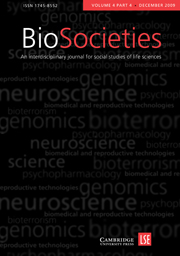Article contents
Framing Women, Framing Fetuses: How Britain Regulates Arrangements for the Collection and Use of Aborted Fetuses in Stem Cell Research and Therapies
Published online by Cambridge University Press: 01 December 2007
Abstract
This article engages with the frequently made claim that the UK has a transparent, accountable and strict but permissive regulatory approach to research using pre-implantation human embryos created in vitro and that this approach provides reassurance to the public in a particularly emotive area, has the full confidence of the scientific and medical research communities, and gives the UK a competitive advantage in the international field of stem cell research. Aborted fetuses are another controversial source of stem cells although their use is less widely known. The paper uses Jasanoff’s conceptual tool of framing to analyse the history of the legislative and governance arrangements for the collection of aborted fetuses for use in stem cell research and therapies in Britain. We argue that the arrangements are confused, lack transparency, are out of line with current good practice on seeking consent, and that non-compliance with regulations is condoned. Furthermore, in our view, the separation of legal and governance arrangements for collection and use of pre-implantation human embryos and aborted fetuses will increasingly become problematic, and we conclude by proposing that there is increasingly a potential for conflict between them.
- Type
- Articles
- Information
- Copyright
- Copyright © London School of Economics and Political Science 2007
References
- 27
- Cited by


